
In the Garhwal Himalayas, a temple holds a special place in Hindu mythology. The Triyuginarayan Temple is in Uttarakhand, India. It’s where Lord Shiva and Goddess Parvati are said to have gotten married. This temple, dedicated to Lord Vishnu, draws many with its rich history and spiritual value.
Key Takeaways
- Triyuginarayan Temple is located in the Rudraprayag district of Uttarakhand, India.
- The temple is dedicated to Lord Vishnu, Shiva, and Parvati, and is renowned for being the site of the divine wedding of Shiva and Parvati.
- The temple features a perpetual fire, known as the Akhand Dhuni, which has been burning since the time of the celestial marriage.
- The etymology of the term “Triyugi Narayan” signifies the offering of wood to the fire in the havan-kund for three yugas.
- The temple is part of the Chardham pilgrimage route, making it a popular destination for devotees and tourists alike.
Introduction to Triyuginarayan Temple: A Divine Wedding Venue

The Triyuginarayan Temple is in the beautiful Garhwal region of Uttarakhand. It’s famous as the place where Lord Shiva and Goddess Parvati got married. This old temple shows the beauty of their union.
Location and Religious Significance
It’s in the Rudraprayag district, at 1,980 feet high. It’s a key place for those who follow Lord Vishnu and Lord Shiva. The village where it’s located is special in Hinduism.
Ancient Origins and Architecture
The temple’s design is unique, showing the Nagara style. It’s a symbol of the area’s rich history. The Eternal Flame here has been burning for ages, adding to its mystique.
Spiritual Importance in Hinduism
It’s known as the place where Lord Shiva and Goddess Parvati got married. This makes it a big draw for those on religious tours. It’s also a favorite spot for couples looking for blessings for their marriages.
The Mythological Significance of Triyuginarayan
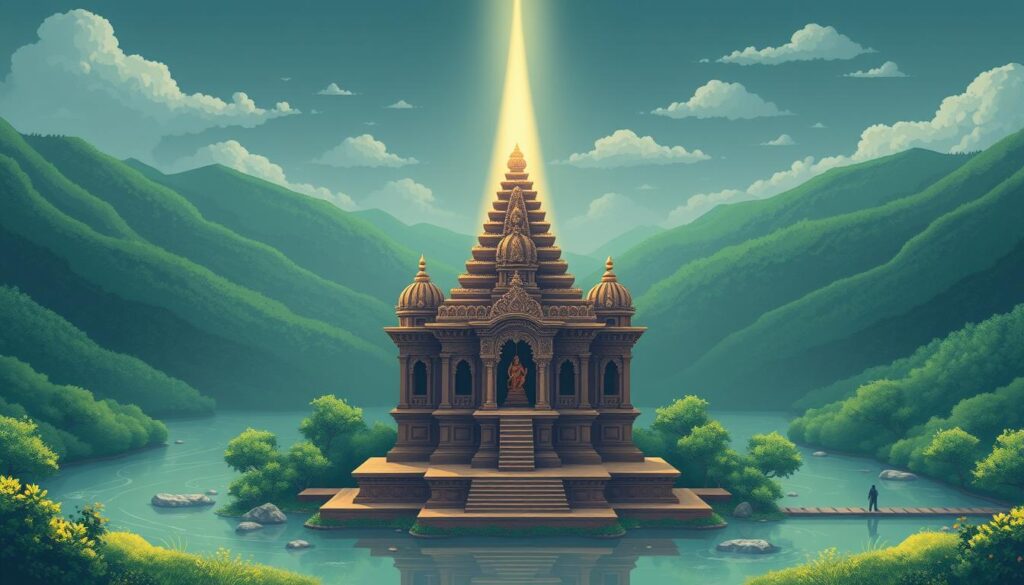
Triyuginarayan is very important in Hindu mythology. It’s where Lord Shiva asked Parvati to marry him at Guptakashi before their big wedding. The temple saw their sacred union in the Satya Yuga. Lord Vishnu was Parvati’s brother, and Lord Brahma was the priest.
This story makes Triyuginarayan a very special sacred place in Hindu tradition.
The name “Triyuginarayan” means “the one who is Lord of the three Yugas.” It shows the temple’s link to the three mythological sites – Satya Yuga, Treta Yuga, and Dwapara Yuga. This makes the temple even more spiritual.
The story of the temple is closely tied to the marriage of Lord Shiva and Goddess Parvati. It’s said that the eternal flame, or Akhand Dhuni, has been burning since their wedding. This flame shows their love and commitment forever.
“The Triyuginarayan Temple is a testament to the enduring power of Hindu mythology and the sacred bond between Lord Shiva and Goddess Parvati.”
The temple’s mythological history and its connection to the divine couple’s wedding make it a key spot for Hindu pilgrims. It’s also a special place for couples looking for a sacred spot to get married.
Temple Where Shiva and Parvati Got Married: Historical Background
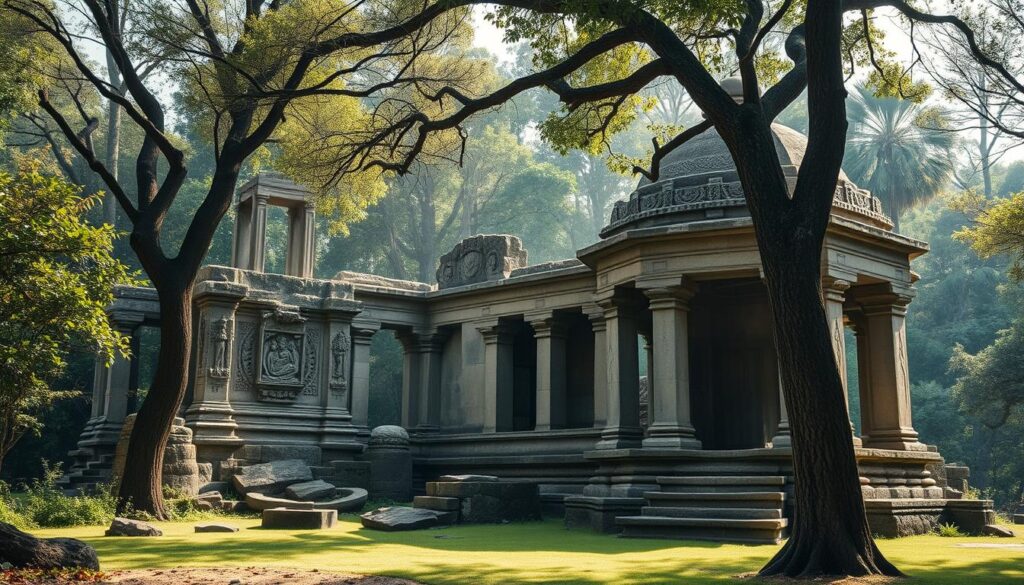
The Triyuginarayan Temple is in the Rudraprayag district of Uttarakhand, India. It’s a place with a rich history. The exact date it was built is unknown, but its design shows it’s very old. It might be connected to the famous Kedarnath Temple.
Ancient Temple Architecture
The Triyuginarayan Temple looks a lot like the Kedarnath Temple. This similarity suggests they share a common history. It shows the temple’s deep roots in ancient traditions.
Historical Timeline and Construction
Legend says the temple was built about 1200 years ago by Adi Shankaracharya. The name “Triyuginarayan” means “wood for three yugas.” It highlights the temple’s enduring importance in Hindu philosophy.
Cultural Heritage Value
The Triyuginarayan Temple is a cultural treasure. It tells the story of Lord Shiva and Goddess Parvati’s wedding. This event, from the Satya Yuga, draws many pilgrims and history lovers. They come to feel the spiritual power of the shiva-parvati wedding.
The Eternal Flame: Akhand Dhuni’s Sacred Story
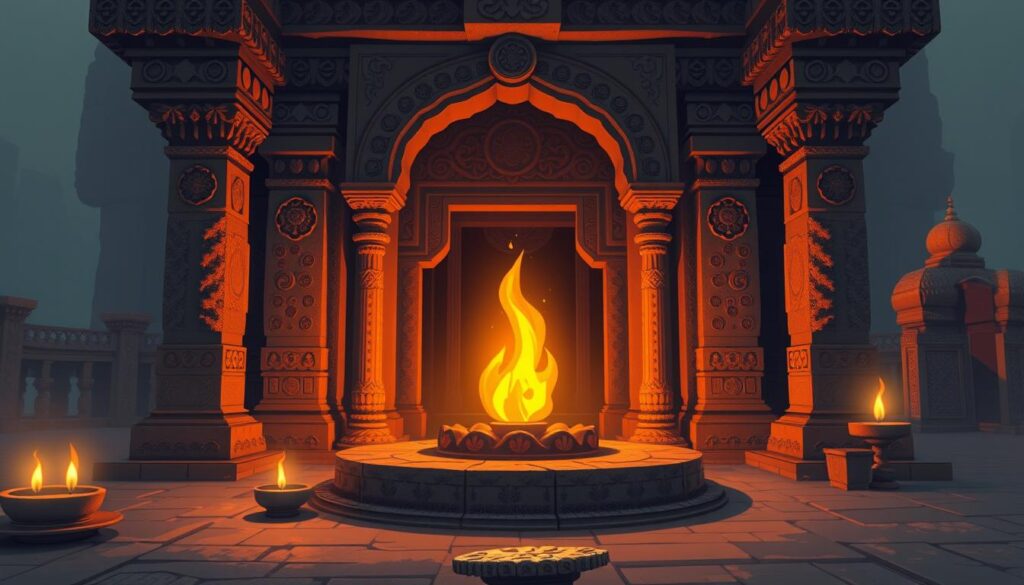
At the heart of Triyuginarayan Temple lies a captivating feature – the Akhand Dhuni, or the eternal flame. This flame is believed to have been burning since the divine wedding of Lord Shiva and Goddess Parvati. It’s a true testament to the temple’s rich spiritual heritage.
The Akhand Dhuni is revered by Hindu pilgrims as a symbol of the eternal and sacred union between Shiva and Parvati. Devotees consider the ashes from this eternal flame as highly auspicious. They often carry them home to promote marital bliss and harmony. The flame’s continued existence, uninterrupted for millennia, is a testament to the temple’s profound spiritual significance within the Hindu faith.
Triyuginarayan Temple’s akhand dhuni, or eternal flame, holds a unique place in the hearts of Hindu devotees. This sacred fire is believed to have been kindled during the divine wedding of Lord Shiva and Goddess Parvati. Pilgrims flock to the temple to witness the flame and collect its ashes. These ashes are believed to bring good fortune and marital harmony to their lives.
“The akhand dhuni is a testament to the timeless love between Shiva and Parvati, and a reminder of the sacredness that permeates every inch of Triyuginarayan Temple.”
The perpetual nature of the akhand dhuni is a testament to the temple’s profound spiritual significance within the Hindu faith. Pilgrims consider the ashes from this sacred fire as highly auspicious. They often carry them back to their homes as a means of promoting marital bliss and familial harmony. The eternal flame’s uninterrupted existence for centuries has cemented Triyuginarayan’s status as a sacred destination for hindu pilgrimage.
Divine Wedding Ceremony and Its Legends
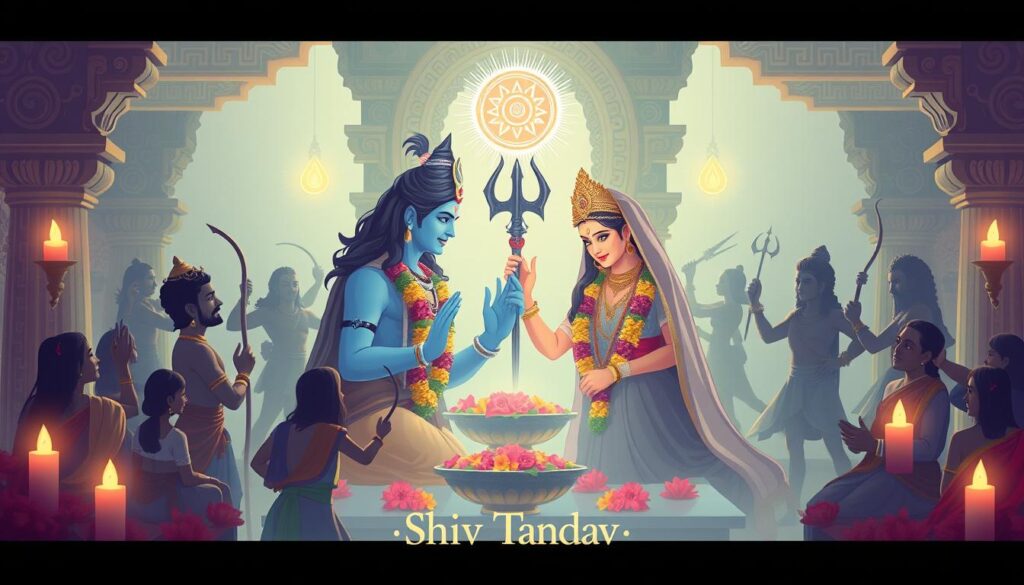
The divine wedding of Lord Shiva and Goddess Parvati at the Triyuginarayan Temple is filled with fascinating stories. Hindu mythology says Lord Vishnu acted as Parvati’s brother. Lord Brahma, the revered priest, made their union eternal.
Role of Lord Vishnu and Brahma
Lord Vishnu changed himself to be Parvati’s brother for the parvati wedding ceremony with Lord shiva parvati marriage. Lord Brahma led the wedding rituals, making the lord shiva marriage blessed.
Sacred Wedding Rituals
The Brahma Shila stone in the temple marks the wedding spot. It’s believed to have seen the sacred rituals that joined Lord Shiva and Goddess Parvati. The temple’s importance as a wedding site is also highlighted by the Akhand Dhuni, an eternal fire lit during the wedding.
“The legends associated with the Triyuginarayan Temple add to its profound spiritual significance as a sacred wedding venue in Hindu mythology.”
The Four Sacred Kunds: Purifying Waters

In the peaceful setting of Triyuginarayan Temple, you’ll find four sacred water tanks called kunds. Each sacred kund has its own special role and spiritual importance. They are thought to have healing powers, making the temple a key spot for Hindu pilgrimage sites.
The four sacred kunds at Triyuginarayan are:
- Rudra-kund – for bathing and purification
- Vishnu-kund – for cleansing and spiritual rejuvenation
- Brahma-kund – for sipping the purifying waters
- Saraswati-kund – for offering libations and prayers
Each sacred kund is believed to have special healing powers, especially for those facing fertility issues. People come to these purifying waters to seek blessings and find spiritual peace. This makes Triyuginarayan Temple a sacred Hindu pilgrimage site.
| Kund | Purpose | Significance |
|---|---|---|
| Rudra-kund | Bathing | Purification and cleansing |
| Vishnu-kund | Cleansing | Spiritual rejuvenation |
| Brahma-kund | Sipping water | Drinking the purifying waters |
| Saraswati-kund | Offering libations | Prayers and rituals |
The sacred kunds of Triyuginarayan Temple show the temple’s deep spiritual and cultural value. They give visitors a chance to dive into ancient traditions and feel a connection with the divine.
Architectural Marvel and Temple Structure
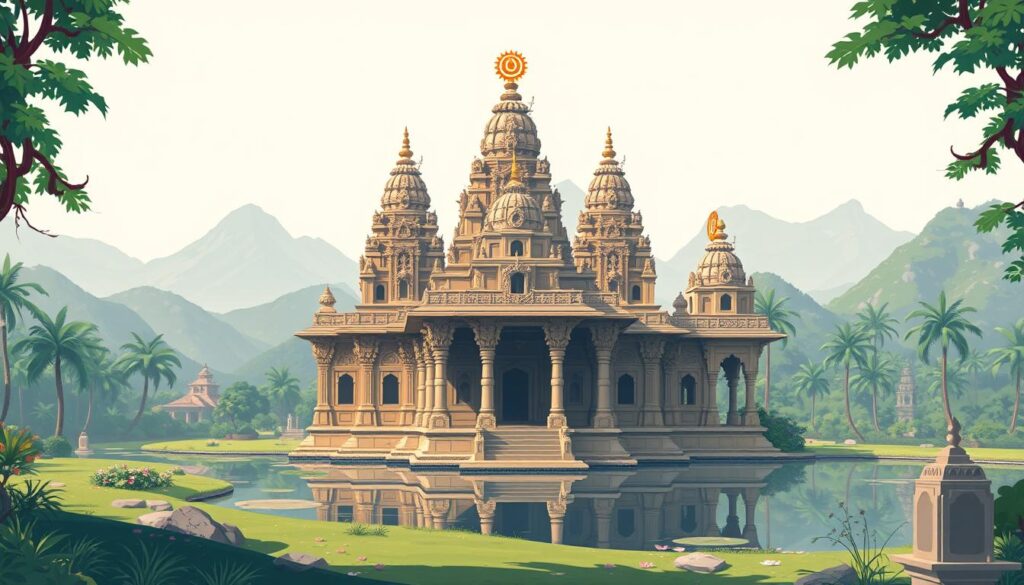
The Triyuginarayan Temple is a stunning example of north Indian architecture that has lasted for centuries. It sits beautifully in the Himalayas. This temple complex shows off the detailed work and timeless designs that have shaped sacred places in the area.
North Indian Architectural Style
The Triyuginarayan Temple follows the Himalayan architectural style. It has detailed carvings and scenes from Hindu myths. The tall spires and fancy front are key parts of North Indian architecture. They show the area’s deep culture and love for the divine.
Temple Complex Layout
- The complex has the main shrine for Lord Vishnu, the eternal Akhand Dhuni (sacred flame), and four sacred kunds (ponds).
- The temple looks a lot like the famous Kedarnath Temple. This shows the shared traditions of ancient Hindu temples in the area.
- People from all walks of life come to the Triyuginarayan Temple. This shows the unity and welcome that the temple complex and its spiritual importance offer.
The Triyuginarayan Temple is a true architectural marvel. It mixes the old traditions of North Indian temple design with the stunning natural beauty of the area. Its temple complex and detailed ancient temple structure draw visitors from all over the world.
Spiritual Significance of Brahma Shila

In the Triyuginarayan Temple, a special stone called the Brahma Shila holds great spiritual value. It’s thought to be the spot where Lord Shiva and Goddess Parvati got married. This makes it a direct link to their divine union.
People visiting the temple show respect to the Brahma Shila. They see it as a sacred object that captures the essence of Shiva and Parvati’s love. It’s a reminder of the deep spiritual meaning of this place.
Those who visit the Brahma Shila perform rituals and pray. They hope for happy marriages, spiritual growth, and to fulfill their dreams. The Brahma Shila is seen as a symbol of the union of male and female divine principles.
The Brahma Shila is more than just a stone. It represents the eternal bond of Shiva and Parvati. It reminds visitors of the spiritual mysteries at the Triyuginarayan Temple. It invites people to feel the deep spiritual energies that have been celebrated for centuries.
Connection with Kedarnath Temple
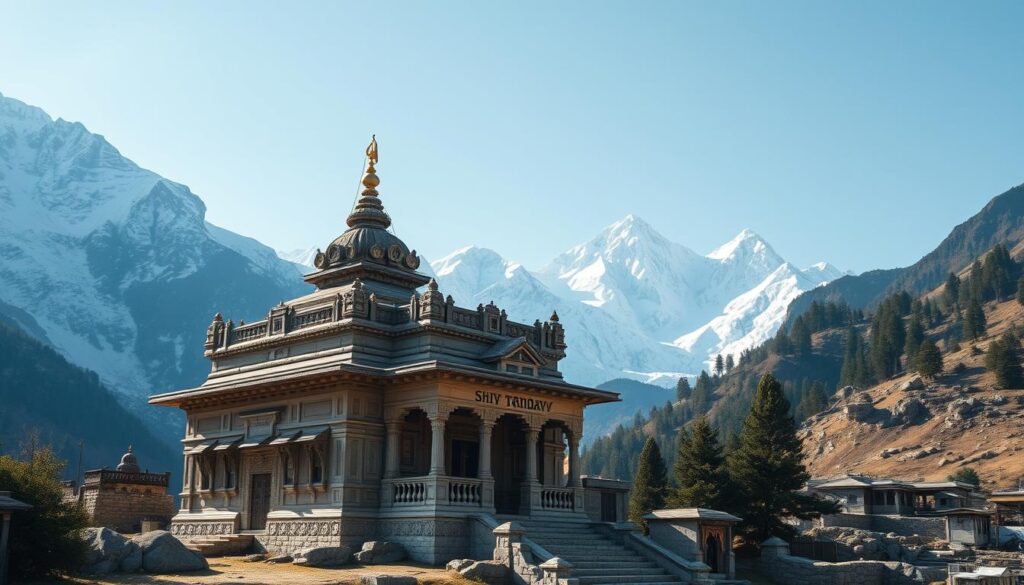
Triyuginarayan Temple is famous for being the place where Lord Shiva and Goddess Parvati got married. It has a strong bond with the well-known Kedarnath Temple. Both places are very important in Hinduism and are key stops for pilgrims.
Architectural Similarities
The designs of Triyuginarayan and Kedarnath Temples look very similar. They both have the North Indian temple style, with big stone buildings and detailed carvings. Kedarnath stands at 3,583 meters, and Triyuginarayan is at about 1,980 meters. Their beauty shows the hard work and faith of the people who built them.
Religious Route Connection
Triyuginarayan and Kedarnath Temples are connected by a special religious path. The Panch Kedar pilgrimage, a famous circuit of five Shiva temples in Uttarakhand, includes both. People visit these temples together, seeking blessings from Lord Shiva and Goddess Parvati.
| Statistic | Value |
|---|---|
| Elevation of Kedarnath Temple | 3,583 m (11,755 ft) |
| Distance from Rishikesh to Kedarnath | 223 km (139 mi) |
| Length of the uphill trek from Gaurikund to Kedarnath | 17 km (11 mi) |
| Temples forming the Panch Kedar pilgrimage sites | Tungnath, Rudranath, Madhyamaheshwar, Kalpeshwar |
Triyuginarayan and Kedarnath are more than just temples. They are connected by their stories of Lord Shiva and Goddess Parvati. Triyuginarayan is where they got married, and Kedarnath is a major pilgrimage site for Shaivites.
Modern-Day Pilgrimages and Religious Tourism

Today, the Triyuginarayan Temple draws many pilgrims and tourists. It’s part of the famous Himalayan pilgrimage routes. The temple’s history and spiritual value make it a key spot in modern religious tourism.
Visitors often visit Triyuginarayan along with other sacred sites like Kedarnath and Badrinath. This creates a full Himalayan pilgrimage experience.
The Triyuginarayan Temple is one of India’s twelve Jyotirlinga temples. These temples are the most sacred Shiva shrines. The Kashi Vishwanath Temple in Varanasi is another example.
The temple’s grand architecture and cultural heritage make it a top spot for Hindu pilgrims and tourists.
Other famous Hindu pilgrimage sites in India include the Brihadiswara Temple in Thanjavur and the Ramanathaswamy Temple in Rameswaram. These temples are known for their massive Shiva lingams and long temple corridors.
These architectural wonders and their spiritual importance draw many religious tourists.
The Triyuginarayan Temple is also linked to the Kedarnath Temple. This connection makes it a key stop for pilgrims. It offers a chance to dive deep into Hindu spirituality and heritage.
In recent years, religious tourism has grown. This has highlighted sacred Hindu sites like the Triyuginarayan Temple. More travelers are looking for real and meaningful experiences. These temples offer a chance to connect with Hinduism’s timeless traditions and spiritual essence.
Sacred Marriage Traditions at Triyuginarayan
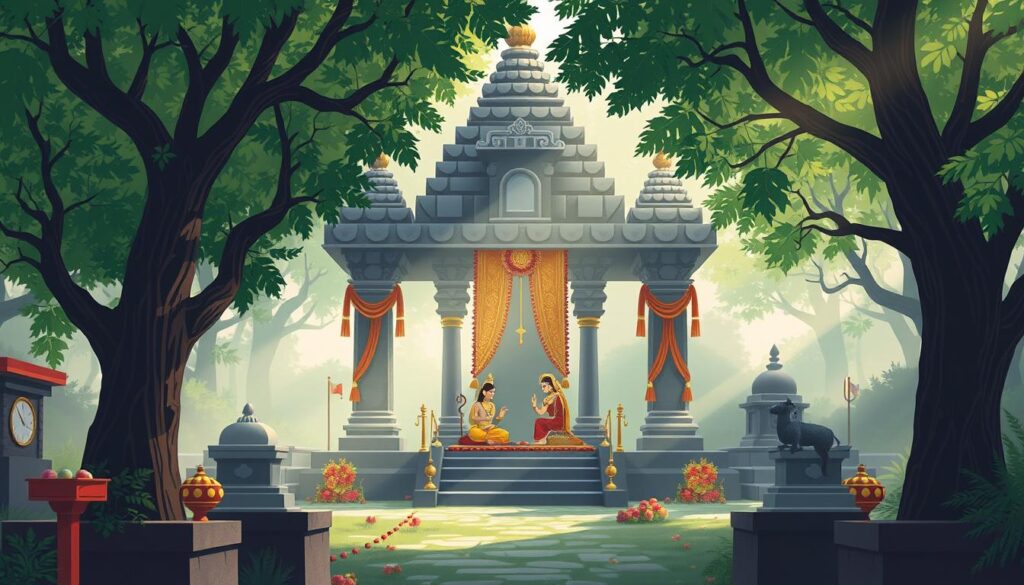
Triyuginarayan Temple is a favorite spot for sacred marriage traditions and wedding ceremonies in India. Many couples pick this place for their wedding, hoping for divine blessings. The temple’s link to the legendary wedding of Lord Shiva and Goddess Parvati makes it special for those wanting a spiritually rich marriage.
Contemporary Wedding Ceremonies
The temple offers a mix of old traditions and new customs for contemporary wedding ceremonies. Couples do special pujas and rituals here, seeking blessings for a happy marriage. The temple’s quiet and exclusive vibe is a nice change from busy city venues.
Significance for Couples
For Hindu followers, Triyuginarayan Temple is very spiritually significant. Couples who marry here feel they’re part of a divine tradition, linking their love to Shiva and Parvati’s. This adds deep meaning to their wedding, making Triyuginarayan a top choice for spiritual tourism.
“The wedding of Shiva and Parvati is a significant event in Indian culture due to its spiritual value.”
As more couples choose Triyuginarayan for their wedding, it’s becoming a key spot for sacred and intimate settings. The temple’s beautiful architecture and the natural beauty around it make the experience unforgettable for the newlyweds.
How to Reach Triyuginarayan Temple

The Triyuginarayan Temple is in the beautiful Uttarakhand region. It’s a favorite spot for both pilgrims and travelers. Getting there is easy, with many ways to travel.
The temple is about 12 kilometers from Sonprayag town. You can take a taxi or bus from there. Or, you can enjoy a 5-kilometer trek through the forest.
For longer trips, Haridwar’s railway station is the closest, 275 kilometers away. Dehradun’s airport is about 240 kilometers. From these places, you can get a taxi or rent a car to reach the temple.
The trip to the temple is stunning, with views of the Himalayas. It’s a memorable journey. The temple’s history, spiritual value, and natural beauty make it a top spot for triyuginarayan travel and uttarakhand pilgrimage in India.
Transportation Options:
- By Road: The temple is 12 km from Sonprayag, accessible by private or public transport.
- Trekking: A 5 km trek through forest trails from Sonprayag is a popular option for adventurous visitors.
- By Rail: The nearest major railway station is in Haridwar, 275 km away.
- By Air: The closest airport is in Dehradun, approximately 240 km from the temple.
Choosing any transportation, the trip to the Triyuginarayan Temple is unforgettable. It’s easy to get there, making it a favorite for many. The temple’s temple access and good transport links make it welcoming to all.
Best Time to Visit and Accommodation Options
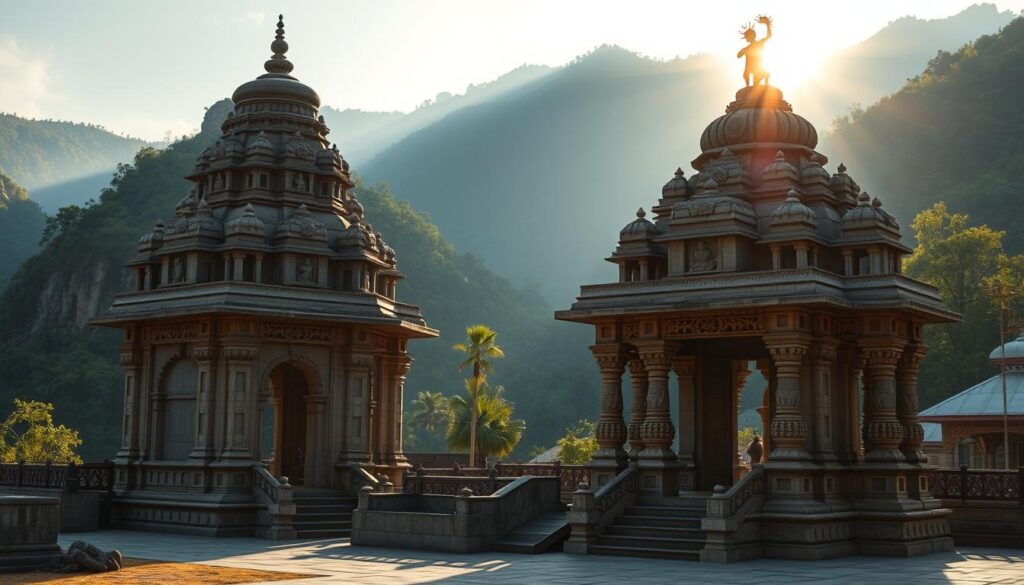
The triyuginarayan visit to the historic Triyuginarayan Temple is best planned from April to November. This time offers nice weather and easy access. It’s perfect for devotees and couples looking for a sacred temple accommodation for their wedding.
For simple stays near the temple, the nearby villages have guesthouses. Prices range from Rs 1,000 to Rs 2,500 per night. For bigger groups and luxury, hotels and resorts in Sonprayag, Guptkashi, and Rudraprayag are better.
| Accommodation Type | Average Cost Per Night | Location |
|---|---|---|
| Guesthouses | Rs 1,000 – Rs 2,500 | Surrounding villages |
| Hotels and Resorts | Varies | Sonprayag, Guptkashi, Rudraprayag |
The pilgrimage season at Triyuginarayan Temple draws many visitors. So, plan your visit and stay early to have a smooth experience.
Conclusion
The Triyuginarayan Temple is a symbol of ancient Hindu traditions and myths. It is the site of Lord Shiva and Goddess Parvati’s divine marriage, watched by Lord Vishnu. This temple is very important for those who want to feel close to their faith.
The temple’s design, in the Nagara style, is stunning. It has a flame that has burned since the gods’ union. This creates a sense of awe and respect. It’s a key place for those on a spiritual journey to find blessings.
Triyuginarayan Temple’s triyuginarayan temple significance goes beyond its myth and faith. It’s also a top spot for weddings, celebrating the love of Shiva and Parvati. Its beauty and spiritual vibe attract visitors worldwide, enriching India’s cultural heritage.
FAQ
Where is the Triyuginarayan Temple located?
The Triyuginarayan Temple is in Triyuginarayan village, Rudraprayag district, Uttarakhand, India.
What is the significance of the Triyuginarayan Temple?
It’s famous as the place where Lord Shiva and Goddess Parvati got married. This makes it a key spot for Hindu pilgrims.
What is the origin of the temple’s name?
The name comes from “tri” (three), “yugi” (era), and “Narayan” (Vishnu). It shows the temple’s long history across three eras.
What is the unique feature of the Triyuginarayan Temple?
It has a constant fire, called the Akhand Dhuni. This fire has been burning since Shiva and Parvati’s wedding.
What is the mythological significance of Triyuginarayan Temple?
Hindu myths say Shiva proposed to Parvati here. Their wedding in the Satya Yuga was a big event, with Vishnu and Brahma playing key roles.
What are the four sacred water tanks or kunds in the Triyuginarayan Temple complex?
There are four kunds: Rudra-kund, Vishnu-kund, Brahma-kund, and Saraswati-kund. Each has healing properties.
What is the significance of the Brahma Shila at the Triyuginarayan Temple?
The Brahma Shila is a sacred stone. It marks the spot of Shiva and Parvati’s wedding, making it a key pilgrimage site.
How is the Triyuginarayan Temple connected to the Kedarnath Temple?
Both temples share architectural styles and are on important pilgrimage paths. They’re linked by the legend of Shiva and Parvati.
What is the significance of the Triyuginarayan Temple for modern-day weddings?
Many couples get married here, hoping for divine blessings. It’s because of its connection to Shiva and Parvati’s wedding.
When is the best time to visit the Triyuginarayan Temple?
Visit from April to November. Avoid the cold winter months.

